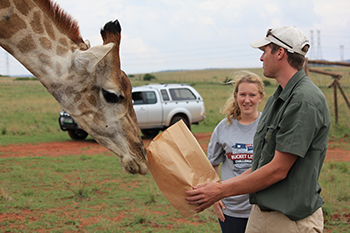
A documentary focusing on the latest and most interesting research about giraffes was recently broadcasted on National Geographic. Dr Francois Deacon from the UFS Department of Animal, Wildlife and Grassland Sciences and the team of researchers working with him, were first in the world to equip giraffes with GPS collars, and to conduct research on them. |
Research by Dr Francois Deacon, from the UFS Department of Animal, Wildlife and Grassland Sciences, involving the equipping of giraffes with GPS collars, was broadcast this week as part of a documentary (4 March 2016 and subsequent weeks) on National Geographic (Channel 182). The documentary is the first of two on his team's research.
Dr Deacon and the team of researchers working with him were the first in the world to equip giraffes with GPS collars, and to conduct research on this initiative. The group of researchers can now follow the animals night and day by means of the GPS collars, while monitoring their movements from a distance on a computer screen and seeing the world from a giraffe's perspective.
“The documentary focuses on the latest and interesting information about our research in different countries,” Dr Deacon said. Besides their local research on giraffes, he and his team also assist in other projects and research in Namibia, Botswana, Zambia, Kenya, the Democratic Republic of the Congo, and Uganda.
“There is much to learn from the documentary,” Dr Deacon said. Interesting facts from their research include herd interactions by individuals towards each other, bulls versus bulls, and cows versus calves. In the documentary, the viewer can also learn how giraffes use thermoregulation, their tongues, and roaming areas and distances; peculiar behaviour such as feeding on bones and soil; bulls fighting; how and when giraffes drink water; and the conservation and management of giraffes.
Focus is also placed on the manner in which the latest research plays a role in the better understanding of the animals.
According to Dr Deacon, this is the first documentary to focus on giraffe research on such a large scale. Marco Polo Films from Terra Mater are contracted by National Geographic to produce nature films – this was the hundredth nature film produced by them.
“There has never before been such a production about giraffes. It also attracted huge interest and reaction overseas, which will provide great exposure for our research and for the UFS.
“We believe that the media involvement will provide much more exposure to giraffes, which is a good thing, since they are facing extinction in Africa. The exposure can, in itself, lead to new research and has already started attracting international students to the UFS,” Dr Deacon said.
The second documentary will follow later this year. Iniosante, a film team from Texas, USA, is producing this film, which focuses on the extinction of giraffes. It is the same team responsible for the production Last of the Longnecks.
Additional resources:
- Last of the Longnecks (trailer)
- Giraffe – Up high and personal (National Geographic video)
- Giraffe: African Giant (National Geographic video)
- Giraffe – Up high and personal (article)